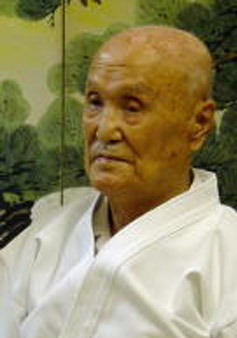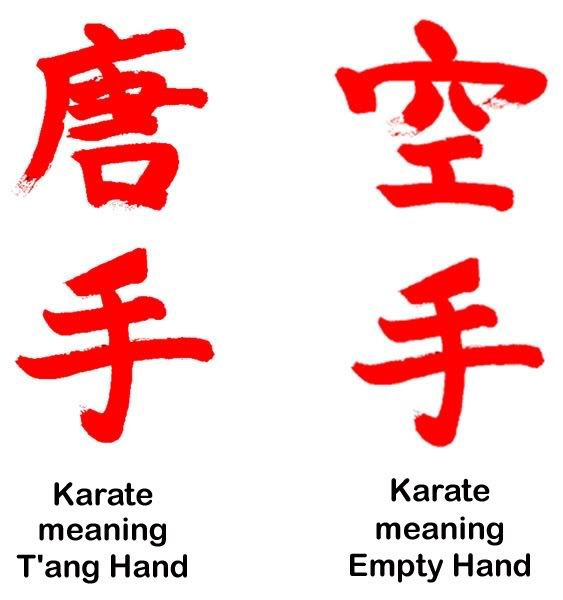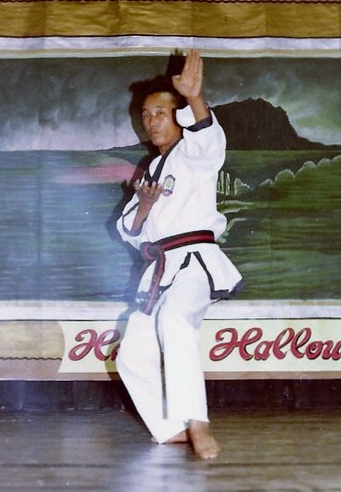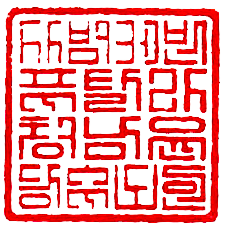Tang Soo Do, “Way of the China Hand” is a relatively new art by name, but with deep roots that go back for centuries. Tang Soo Do is a popular Korean art practiced by hundreds of thousands of people around the world today. The name was first used in 1944 by Grandmaster Won Kuk Lee who had returned from Japan at the end of the Japanese occupation of Korea.

A student of Shotokan founder Gichin Funakoshi and his son Gigo Funakoshi, Won Kuk Lee was the highest-ranking non-Japanese in the Shotokan dojo.
Rather than use the name Shotokan, Lee used the Korean pronunciation of Karate (Tang Soo Do) as it was written in Japan at the time, which meant “Way of the China Hand” or “Tang Hand” (See below)

Tang Soo Do had become quite popular throughout Korea, and when Lee named his dojang Chung Do Kwan, he stopped using the name Tang Soo Do. It was in the early 1950’s that Moo Duk Kwan founder GM Hwang Kee began calling what he taught Tang Soo Do Moo Duk Kwan, taking the place of the old name “Hwa Soo Do” which was not very popular in Korean society.
Hwang Kee and his Moo Duk Kwan would become closely related to the art of Tang Soo Do even after he had evolved what he taught into Soo Bahk Do as it is known today. He is mistakenly called the founder of Tang Soo Do, but he is the founder of the Moo Duk Kwan.
NOT An Ancient Korean Art
The most common history given for Tang Soo Do is that it is an ancient form of Korean martial art derived from the art of Subahk during the Three Kingdoms Period in Korea and was also influenced by the ancient Korean art of Taekyon. In reality, Tang Soo Do is only 81 years old from the time the name was first used.
Because Hwang Kee adopted the name after it had become popular, it was associated with the Moo Duk Kwan as its popularity grew, and Hwang Kee was thought to be the founder. Even early Tang Soo Du under Won Kuk Lee closely resembled Shotokan Karate, but Hwang Kee taught that it was an ancient Korean art.
To explain the similarities to Shotokan Karate and the Japanese Karate systems, it was said that Hwang Kee found a book by Gichin Funakoshi while working on the railroad and mastered the contents and forms, adopting them into his teachings.
The truth is that after the brutal occupation of Korea by Japan (1910 – 1945) Korea wanted NOTHING associated with Japan or being Japanese. Won Kuk Lee brought Shotokan Karate to Korea and began teaching Shotokan in Korea in 1944. He would “Koreanize” the art, using what he learned in Taekyon and his travels through China, but when Hwang Kee began using the name Tang Soo Do, the history changed to make it a strictly Korean art, which is not true.
Being that Tang Soo Do as it is known today can be traced back to Japan and Gichin Funakoshi, that means it can be traced back further to Okinawa and even China, making its roots very deep indeed!
Why “Traditional” Tang Soo Do?
So why do I refer to what I practice and teach “Traditional” Tang Soo Do?
Well…since leaving Korea in 1986, I looked for Tang Soo Do schools everywhere I went after returning to the U.S. In more than ten years I only found three, and they were nothing like what I learned in Korea under Master Yun.
One was more Tae Kwon Do Moo Duk Kwan than Tang Soo Do and was all about competition. The second was a Soo Bahk Do Moo Duk Kwan dojang, but Soo Bahk Do became something totally different and that dojang was more concerned with who was senior to whom and their individual status than teaching a quality martial art.

The last dojang advertised that they taught Tang Soo Do and Chun Kuk Do, Chuck Norris’ martial system. I participated in the class and not only did the instructor butcher the name, call ing it Tang (like the juice) Soo Doo (Like Scooby Doo), but the pyung ahn forms were not performed right, and the school was just severely lacking.
Looking at Tang Soo Do videos on YouTube, most organizations and schools are all about tournaments and flashy techniques, much like Tae Kwon Do. Many of the videos I see have weird breathing techniques and footwork, either stomping around or moving around awkwardly.
Over the years I have had the opportunity to study Shotokan Karate for over 3 years, and earned my 2nd Dan in Chung Do Kwan. I realized that the Tang Soo Do taught to me by Master Yun adhered to the original Tang Soo Do taught during the early years of Hwang Kee’s teaching and was the same as the early Chung Do Kwan schools before they went the way of TKD.
I have yet to see any Tang Soo Do dojang today teach the same technique taught by Master Yun. It was a very traditional, old school dojang and taught the “Traditional” Tang Soo Do before Hwang Kee evolved into Soo Bahk Do, and the same Tang Soo Do that was taught by Won Kuk Lee before he evolved the Chung Do Kwan adopting the Poomse forms and falling under the Tae Kwon Do banner.
That is why I refer to the Tang Soo Do I practice as Traditional Tang Soo Do and went a step further to call it Chung Nam Yun Tang Soo Do to honor the location of the Master Yun’s dojang and my honored instructor.

